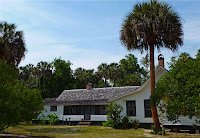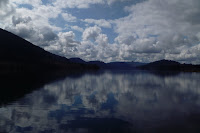Plans are to meet with a Family Promise of Volusia County (Florida) Board member in Daytona for lunch, then to head up to Bunnell for the first meeting of folks wishing to develop Family Promise of Flagler County.
 |
| Paynes Prairie |
My morning route takes me south from Gainesville on Hwy 441, first past Paynes Prairie State Preserve, that sea of grass, sedges, and flowering plants whose wet lands harbor alligators, wild horses, bison, and a multitude of herons, egrets, ibis and other birds. I then roll through Micanopy toward McIntosh and Orange Lake, rural countryside dotted with alligator-laden lakes. Between Micanopy and McIntosh, I note signs for the homestead of Marjorie Kinnan Rawlings, author of The Yearling. This is the sandy soil of which she writes.
It seems to me that the earth may be borrowed but not bought. It may be used but not owned. It gives itself in response to love and tending, offers its seasonal flowering and fruiting. But we are tenants and not possessors, lovers and not masters. Cross Creek belongs to the wind and the rain, to the sun and the season, to the secrecy of seed, and beyond all, to time. ---Marjorie Kinnan Rawlings, Cross Creek
Orange Lake
I think, I wish I could write like Marjorie. I do like the things she thinks about. I think on the land as I drive on. Soon I’m in Marion County, in the midst of beautiful horse farms on rolling green land. Foals cavort in the fields as I drive by. I wish I had time to stop and watch for a while.
 |
| Marion County Horse Farm |
Who knows, I could see a future Triple Crown winner testing his legs! Instead I take a bypass around Ocala and head east on Hwy 40, through the Ocala National Forest, the southernmost forest in the continental United States.
The Ocala National forest is the world’s largest contiguous sand pine scrub forest, high dry sandy ridges of pine and palmetto rich in water, including more than 600 creeks, lakes, rivers and springs. Signs warn to watch for bears and deer crossing the road. I've seen deer in the past, as well as lanky sandhill cranes, but never a bear. I pass through small crossroads of convenience stores, gas stations, and mobile homes clustered around small lakes. The land becomes more isolated and soon there are few signs of civilization. I stop at Wildcat Lake. The sky is blue, the lake is blue, the trees are green. It is a beautiful day in the forest!
 |
| Wildcat Lake, Ocala National Forest |
I do not know how any one can live without some small place of enchantment to turn to.
Marjorie Kinnan Rawlings
 |
| Fern Farm |
I breathe, take a few photographs and move on. Just past Astor are the fern farms, row after row of tropical greenery thriving under translucent tents. Soon I find myself in Barberville, the intersection of Hwys 40 and 17.
This small community always makes me smile. Its landmark (for me) is the garish Barberville Roadside Fruit Stand, which sells much more than fruit - including bright yellow metal sunflowers, colorful imported pots, and tall, bright statues . . . of dinosaurs, chickens, horses and various and sundry other .... critters. I should stop some time and check out the quality of its wares. For now I just smile and move on.
 |
| Barberville Fruit Stand |
This small community always makes me smile. Its landmark (for me) is the garish Barberville Roadside Fruit Stand, which sells much more than fruit - including bright yellow metal sunflowers, colorful imported pots, and tall, bright statues . . . of dinosaurs, chickens, horses and various and sundry other .... critters. I should stop some time and check out the quality of its wares. For now I just smile and move on.
In short order I am in Daytona. I am scheduled to meet Audrey at a restaurant located across from the Daytona Speedway, home of the renowned Daytona 500 NASCAR race. I am a bit early, so I stop to take a few photographs of the Speedway. Though I normally prefer wild places, this edifice fascinates me. The track is a 2.5 mile "trioval." I’m not quite sure what a trioval is, but I do know that the track is enormous.
After a warm, long lunch with Audrey and updates on Family Promise of Volusia County, I head up I-95, then exit west onto SR 100 at Palm Coast. Flagler County is composed of three distinct communities, Flagler Beach, Palm Coast, and Bunnell. Flagler Beach, known for its orange-colored sand, is sandwiched between the beaches of St. Johns County to the north and Volusia County to the south, both of which allow cars to drive on the beach. I personally prefer unmotorized beaches, which is one of the reasons I appreciate Flagler Beach (which even has a stretch sans buildings that runs alongside A1A). When I drive through Palm Coast I think of new Florida, subdivisions of ranch-style homes set amid thick lawns of St. Augustine grass. Palm Coast and Bunnell are connected by a corridor of pine trees and modern strip mall.
 |
| Daytona Speedway |
There is a 29 acre lake in the infield! Because of the diverse schedule of races held at this speedway, it has earned the name World Center of Racing. I smile at the photos of drivers adorning the track supports, then head over for my meeting with Audrey.
After a warm, long lunch with Audrey and updates on Family Promise of Volusia County, I head up I-95, then exit west onto SR 100 at Palm Coast. Flagler County is composed of three distinct communities, Flagler Beach, Palm Coast, and Bunnell. Flagler Beach, known for its orange-colored sand, is sandwiched between the beaches of St. Johns County to the north and Volusia County to the south, both of which allow cars to drive on the beach. I personally prefer unmotorized beaches, which is one of the reasons I appreciate Flagler Beach (which even has a stretch sans buildings that runs alongside A1A). When I drive through Palm Coast I think of new Florida, subdivisions of ranch-style homes set amid thick lawns of St. Augustine grass. Palm Coast and Bunnell are connected by a corridor of pine trees and modern strip mall.
Bunnell, population less than 5,000, represents old Florida to me. Indeed, descriptions of the county report that Bunnell is one of the oldest communities along the east coast of Florida. The town is named after Alvah Bunnell, who established a small cypress shingle mill in the area in the late 1800s. The abundance of pines allowed for growth of turpentine businesses in the area as well. Town is composed of low rise, historic buildings of stone, red brick, and wood. A source of pride is City Hall, erected in 1936-37 and built of coquina, that soft, white Florida rock composed of crushed marine shells and coral. As I enter from the east I am greeted by a stereotypical name-emblazoned water tower. Its been several years since I’ve been through Bunnell, and I am surprised to note the large, modern county government building.
After dinner with Jim and Jackie, who are spearheading the Family Promise development efforts in Flagler County, we host a meeting at First United Methodist Church of folks from the community who are interested in developing a Family Promise affiliate. This community has a strong interest in serving homeless persons, and there is much excitement in the room. By the time we’re finished, violin-playing Father Al from Santa Maria del Mar Catholic Church has invited everyone to attend the next meeting at his church, which will include an italian dinner cooked by Father Al himself!
After dinner with Jim and Jackie, who are spearheading the Family Promise development efforts in Flagler County, we host a meeting at First United Methodist Church of folks from the community who are interested in developing a Family Promise affiliate. This community has a strong interest in serving homeless persons, and there is much excitement in the room. By the time we’re finished, violin-playing Father Al from Santa Maria del Mar Catholic Church has invited everyone to attend the next meeting at his church, which will include an italian dinner cooked by Father Al himself!
Satisfied with a day that included interaction with numerous good-hearted folks as well as drives through intriguing countryside, I soon turn toward home. I take Hwy 100 west toward Palatka, through farms of cabbage and potatoes and across the St. Johns River. Then I head on in on through more sandy pine forest interspersed with ponds and lakes. It is late by now, quite dark, and I content myself with thinking of this day, as well as times past. I have held jobs before that confined inside buildings all day. Those were difficult days. I am grateful for a job that allows me to traverse the countryside while working with good people at a good and necessary task. Though the land I traveled today may not include mountains and cliffs, it has its own beauty, or as Marjorie describes, it’s own enchantment.
Enchantment lies in different things for each of us. For me, it is in this: to step out of the bright sunlight into the shade of orange trees; to walk under the arched canopy of their jadelike leaves; to see the long aisles of lichened trunks stretch ahead in a geometric rhythm; to feel the mystery of a seclusion that yet has shafts of light striking through it. This is the essence of an ancient and secret magic. --Marjorie Kinnan Rawlings
Donna
©May 5, 2011
Photos of Marjorie Kinnan Rawlings' Homestead in Cross Creek
 |
| Barn |
 |
| Main House |
 |
| Inside Barn |
 |
| Marjorie's beloved orange trees |
 |
| House for Caretakers |






















